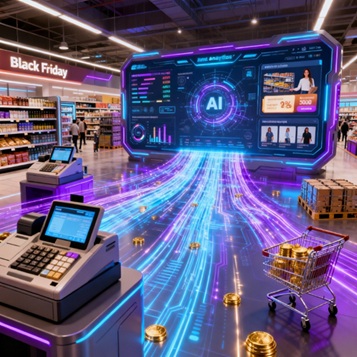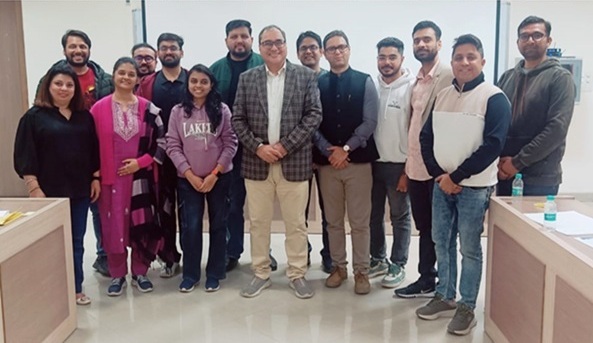by Dr. Keerti Jain
Imagine a global retail company on Black Friday, flooded with millions of customer transactions per second. Last year, delays in processing these transactions caused supply shortages on hot-selling items and lost revenue. This year, thanks to real-time analytics powered by AI powered analytics tools and edge computing, data flows instantly from stores to decision-makers. Stock levels adjust on the fly, personalized promotions reach customers in moments, and the company sets new sales records—all powered by smart data insights.
This story captures the profound transformation analytics is undergoing today. No longer just a back-office function, analytics has evolved into a dynamic, real-time, and AI-powered practice embedded in every part of business. As we look to the future in 2025 and Data Analytics Trends 2026, AI business analytics will become even more intelligent, accessible, and ethical shaping how organizations compete, innovate, and grow.
How Real-Time and AI-Powered Analytics Are Transforming Business
Analytics is undergoing a rapid transformation driven by advances in artificial intelligence, cloud computing, and real-time data processing. As we navigate 2025 and beyond, analytics is evolving from traditional historical reporting into a dynamic, AI-powered function that empowers organizations to make faster, smarter decisions.

Key Trends Shaping Real Time Analytics
Real-Time Analytics and Velocity
The future lies in processing and analyzing data in real-time. For example, Snowflake’s Snowpipe streaming technology offers 10x lower latency for queryable data, while Google PubSub streams directly into BigQuery for instant insights. Walmart uses a massive hybrid cloud to analyze sales and manage supply chains in real-time analytics, illustrating the competitive edge from timely data.
Data Quality and Veracity
Ensuring data accuracy remains a priority as fresher data can bring risks of incompleteness. Emerging observability tools monitor data freshness, schema evolution, volume, distribution, and lineage to maintain data health. Governance frameworks ensure compliance with regulations like GDPR and CCPA, protecting both data quality and privacy with AI-powered analytics tool.
AI and Machine Learning Integration
AI-powered Analytics increasingly leverages AI and ML for automated decision-making and pattern recognition. Use cases span healthcare detection, manufacturing predictive maintenance, and automated marketing optimization. Technologies like generative AI and retrieval-augmented generation (RAG) are pushing innovation boundaries in data synthesis and context-aware insights.
Democratization of Analytics
Advanced analytics capabilities are becoming accessible beyond data scientists. No-code and low-code tools enable business users to independently explore and visualize data, driving a data-literate culture. Data mesh architectures empower cross-functional teams to own and analyze their data products independently.
Composable and Modular Architectures:
Organizations are building flexible analytics stacks by integrating best-of-breed AI business analytics tools via open APIs instead of relying on monolithic systems. This modularity enables agility in adopting new technologies and optimizing costs.
Ethics and Responsible AI:
Companies are adopting AI governance frameworks focused on fairness, bias mitigation, transparency, and ethical data use. Regular model audits, bias detection tools, and training programs are becoming standard to maintain stakeholder trust and regulatory compliance with both AI-powered analytics and AI business analytics.
Data Analytics Trends 2026 and the Data and Skills Outlook to 2030
- The global data analytics job market is projected to grow, with the World Economic Forum forecasting 170 million new jobs by 2030 due to digital transformation and automation a net 7% increase in employment.
- Essential technical skills will include Python, R, SQL, cloud platforms (AWS, GCP, Azure), and machine learning models. Soft skills like critical thinking, problem-solving, data storytelling, and cross-functional collaboration will be equally vital.
- Emerging skills emphasize AI/ML model interpretation, ethical governance, automation with AutoML platforms, and domain expertise in sectors like healthcare, finance, and retail. Keeping pace with evolving tech and ethical frameworks is critical for career success. Professionals with skills & experience in AI-powered analytics tool and AI business analytics will be in high demand.
Business Impact and Vision in AI Business Analytics
Analytics is transitioning from a support function to a strategic differentiator. Companies investing in data literacy, real-time capabilities, ethical AI, and flexible architectures can generate actionable insights faster and monetize real-time analytics outputs as valuable products. Cross-functional collaboration breaks down barriers between technical and business roles, accelerating innovation.
In conclusion, the future of analytics is intelligent, collaborative, real-time, and ethical. Organizations that embrace these shifts will harness data to drive growth, agility, and competitive advantage in an increasingly complex data landscape with AI Business Analytics tool.
References
- Monte Carlo Data. “Future Of Data Analytics: 10 Trends to Watch out for In 2025.” Published July 2025.
- Datamites. “Future of Data Analytics: What Skills Will Matter by 2030?” Published April 2025.
- IABAC. “Future of Data Analytics: AI and ML Trends.” Published May 2024.
- Acceldata. “Embracing the Future of Data Analytics: Key Drivers.” Published October 2024.




